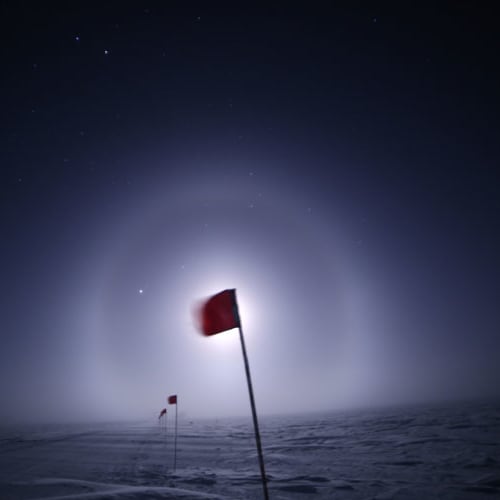Cold
The snow reflects the sun’s solar radiation, and this combined with high altitude (much of the continent is over 9,800 feet above sea level) makes the interior of Antarctica the coldest place on Earth. The lowest recorded Antarctic temperature was taken at Vostok Station in July 1983: -89.2°C (-128.6°F). The lowest South Pole temperature is from June 23, 1982: -82.8°C (-117.0°F). The warmest temperature ever recorded at the South Pole, recorded at the height of the austral summer, December 25, 2011, was still well below freezing: -12.3°C (+9.9°F).
Wind
The strong winds of Antarctica are called katabatics, formed by cold, dense air flowing out from the polar plateau of the interior down the steep vertical drops along the coast. It is at the steep edge of Antarctica that the strong katabatic winds form as cold air rushes over the land mass. The highest wind speeds recorded in Antarctica were at Dumont d’Urville station in July 1972: 327km/h (199 mph). Because the South Pole is well inland and on a flat area of the plateau, the katabatic winds are relatively mild. The highest recorded wind at the South Pole was only 50 knots (58 mph).

Halos
Halos are optical phenomena that result from light interacting with ice crystals in the atmosphere. Variations in halos are caused by different combinations of ice crystal shapes and orientations as well as different combinations of reflections and refractions within the crystals. The most common halos are the 22-degree halo (a circle around the sun or moon) and the parhelion, also known as a sun dog (bright spots of light on either side of the sun). Though these more common halos can be seen elsewhere in the world, the unique atmospheric conditions in Antarctica make it an especially great place to see and study halos; there are a number of halo types that have only been observed at the South Pole.
South Pole
The South Pole is at an altitude of 9,300 feet. Because of the altitude and its location in the middle of the polar plateau, the temperature remains very low. There is only one sunrise and one sunset each year at the South Pole: the sun rises on September 21 and sets on March 21. During the summer months the sun slowly spirals up to its maximum height and then back down to the horizon again over a six-month period, never setting until March 21, when the sun then remains below the horizon for the next six months. It is during the dark winter months that the South Pole is at its most extreme cold.
- Highest Recorded Temperature +9.9°F (-12.3°C) December 25, 2011
- Lowest Recorded Temperature -117.0°F (-82.8°C) June 23, 1982
- Average Annual Temperature -57.1°F (-49.5°C)
- Peak Wind 50 kts (58 mph) on September 27, 2011
- Average Wind 10.7 kts (12.3 mph)
- Maximum Pressure 719.0 mbs on August 25, 1996
- Minimum Pressure 641.7 mbs on July 25, 1985
- Average Pressure 681.3 mbs
